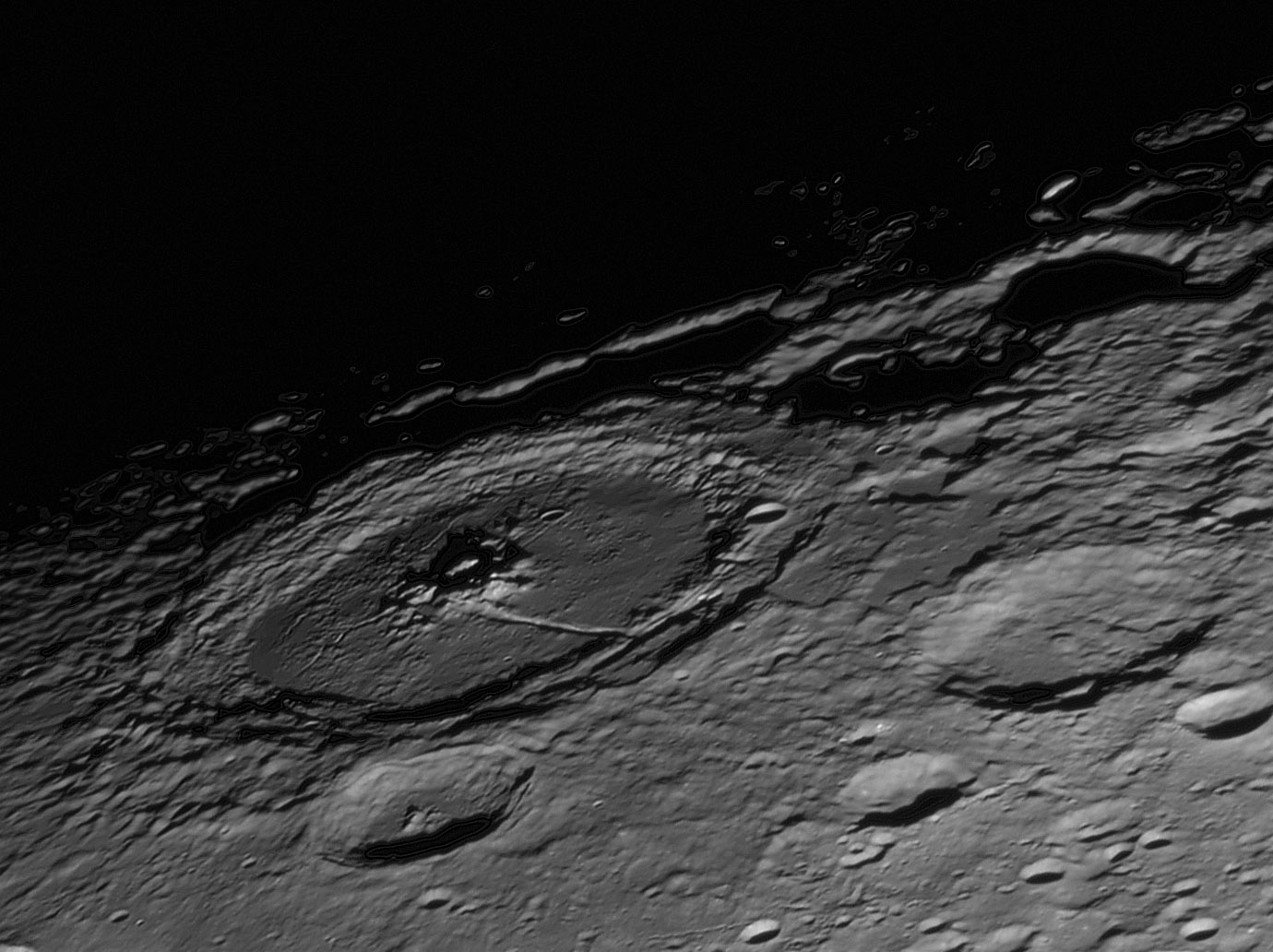Difference between revisions of "September 8, 2009"
| Line 1: | Line 1: | ||
__NOTOC__ | __NOTOC__ | ||
=Sharing the Spotlight= | =Sharing the Spotlight= | ||
| − | |||
<!-- ws:start:WikiTextHeadingRule:0:<h1> --> | <!-- ws:start:WikiTextHeadingRule:0:<h1> --> | ||
<!-- ws:start:WikiTextLocalImageRule:6:<img src="/file/view/LPOD-Sept8-09.jpg/87563395/LPOD-Sept8-09.jpg" alt="" title="" /> -->[[File:LPOD-Sept8-09.jpg|LPOD-Sept8-09.jpg]]<!-- ws:end:WikiTextLocalImageRule:6 --><br /> | <!-- ws:start:WikiTextLocalImageRule:6:<img src="/file/view/LPOD-Sept8-09.jpg/87563395/LPOD-Sept8-09.jpg" alt="" title="" /> -->[[File:LPOD-Sept8-09.jpg|LPOD-Sept8-09.jpg]]<!-- ws:end:WikiTextLocalImageRule:6 --><br /> | ||
| − | <em>image by [mailto:starman2@allegiance.tv Wes Higgins]</em><br /> | + | <em>image by [mailto:starman2@allegiance.tv" rel="nofollow Wes Higgins]</em><br /> |
<br /> | <br /> | ||
| − | Petavius is perhaps the most fascinating crater along the eastern limb of the Moon. It is young enough to have its massive central peaks and blocky terraces reasonably well preserved, but what sets it apart from Langrenus and similar complex craters is the character of its floor. The trench that runs from the central peaks to the western wall is not matched by any other crater rille on the Moon. An amazing connection, only hinted at here but revealed by both the [http://www.lpod.org/coppermine/displayimage.php?pid=3043&fullsize=1 Lunar Orbiter IV] and the Chinese [http://www.clep.org.cn/index.asp?modelname=tpxshang%5Fnr&FractionNo=&titleno=tpxshang&recno=731 Chang'e-1] images, is that the massive main rille bends sharply at the peak and continues northward (to the left), becoming increasingly narrow. Another rille radiates southward from the peaks. Like the main rille and the one to the north, it too is broader near the peaks and thins away from them. This [http://www.lpod.org/?m=20060814 suggests] that all three are related to uplift of the peaks and the center of the floor. Previous [http://www.lpod.org/?m=20071120 observations] indicated that the center of Petavius has been uplifted, but confirmation awaits high quality topography. Two types of material flowed in and near Petavius. The odd dome just under the southern wall was presumably made of erupted lavas, and the smooth ponds of material beyond the southern rim are impact melt. With all these fascinating features what could Petavius possibly be sharing the spotlight with here? Forgetting [http://the-moon.wikispaces.com/Wrottesley Wrottesley], note the battered Snellius at bottom right - is it the only lunar crater that looks like it was repeatedly pitted with a ball peen hammer?<br /> | + | Petavius is perhaps the most fascinating crater along the eastern limb of the Moon. It is young enough to have its massive central peaks and blocky terraces reasonably well preserved, but what sets it apart from Langrenus and similar complex craters is the character of its floor. The trench that runs from the central peaks to the western wall is not matched by any other crater rille on the Moon. An amazing connection, only hinted at here but revealed by both the [http://www.lpod.org/coppermine/displayimage.php?pid=3043&fullsize=1" rel="nofollow Lunar Orbiter IV] and the Chinese [http://www.clep.org.cn/index.asp?modelname=tpxshang%5Fnr&FractionNo=&titleno=tpxshang&recno=731" rel="nofollow Chang'e-1] images, is that the massive main rille bends sharply at the peak and continues northward (to the left), becoming increasingly narrow. Another rille radiates southward from the peaks. Like the main rille and the one to the north, it too is broader near the peaks and thins away from them. This [http://www.lpod.org/?m=20060814" rel="nofollow suggests] that all three are related to uplift of the peaks and the center of the floor. Previous [http://www.lpod.org/?m=20071120" rel="nofollow observations] indicated that the center of Petavius has been uplifted, but confirmation awaits high quality topography. Two types of material flowed in and near Petavius. The odd dome just under the southern wall was presumably made of erupted lavas, and the smooth ponds of material beyond the southern rim are impact melt. With all these fascinating features what could Petavius possibly be sharing the spotlight with here? Forgetting [http://the-moon.wikispaces.com/Wrottesley Wrottesley], note the battered Snellius at bottom right - is it the only lunar crater that looks like it was repeatedly pitted with a ball peen hammer?<br /> |
<br /> | <br /> | ||
| − | <em>[mailto:tychocrater@yahoo.com Chuck Wood]</em><br /> | + | <em>[mailto:tychocrater@yahoo.com" rel="nofollow Chuck Wood]</em><br /> |
<br /> | <br /> | ||
<strong>Technical Details</strong><br /> | <strong>Technical Details</strong><br /> | ||
Revision as of 18:12, 4 January 2015
Sharing the Spotlight

image by " rel="nofollow Wes Higgins
Petavius is perhaps the most fascinating crater along the eastern limb of the Moon. It is young enough to have its massive central peaks and blocky terraces reasonably well preserved, but what sets it apart from Langrenus and similar complex craters is the character of its floor. The trench that runs from the central peaks to the western wall is not matched by any other crater rille on the Moon. An amazing connection, only hinted at here but revealed by both the " rel="nofollow Lunar Orbiter IV and the Chinese " rel="nofollow Chang'e-1 images, is that the massive main rille bends sharply at the peak and continues northward (to the left), becoming increasingly narrow. Another rille radiates southward from the peaks. Like the main rille and the one to the north, it too is broader near the peaks and thins away from them. This " rel="nofollow suggests that all three are related to uplift of the peaks and the center of the floor. Previous " rel="nofollow observations indicated that the center of Petavius has been uplifted, but confirmation awaits high quality topography. Two types of material flowed in and near Petavius. The odd dome just under the southern wall was presumably made of erupted lavas, and the smooth ponds of material beyond the southern rim are impact melt. With all these fascinating features what could Petavius possibly be sharing the spotlight with here? Forgetting Wrottesley, note the battered Snellius at bottom right - is it the only lunar crater that looks like it was repeatedly pitted with a ball peen hammer?
" rel="nofollow Chuck Wood
Technical Details
09-06-09, 8:48 UT. 18" Reflector, Infinity 2-1m camera , stack of 204 frames, MAP 1856 Avistack
Related Links
Rükl plate 59



